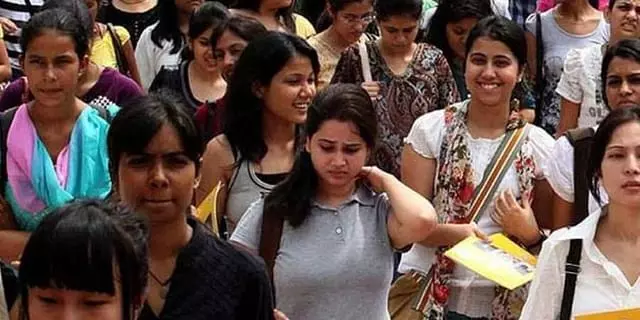
Women's education: Heart-warming numbers from govt's AISHE survey
There is big rise in women's enrollment in higher education, but significant structural weaknesses that go against interests of women remain, says report

The All-India Survey on Higher Education (AISHE) released last week by the Ministry of Education of the Government of India, meant for the year 2021-22, tells us some heart-warming stories.
India now has about 1,168 university-level institutions, 45,473 colleges and 12,002 stand-alone institutions. This is a stupendous achievement. In 1947, we had only about 20 universities, with about 2.41 lakh students enrolled in about 500 colleges. Even after accounting for the quadrupling of the headcount in India, the current numbers reflect a huge leap in the spread of institutionalised higher education.
The one area worth focusing on is the surge in women’s participation in higher education across several metrics.
More women in colleges
When we became a republic in 1950, the enrollment of women in higher education was a low 10.9 %. It is now a very healthy 48%. Of about 4.33 crore students enrolled in colleges across India, nearly half – about 2.07 crore – are women, indicating how aspirational levels have risen across gender divide.
Across social categories such as Schedule Castes, Schedule Tribes and minorities, the enrollment of women has notched up significant hikes and not just among students. Among the nearly 16 lakh faculty members, about 56.6% are men and 43.4% are women, with the ratio of women faculty steadily nudging upwards.
In some areas women are surging ahead of men. In the northeastern region, for instance, the enrolment of women in colleges in 2021-22 was higher than that of men. Another bright spot is the female GER (Gross Enrolment Ratio - the ratio of people enrolled in higher education to the population in the age group of 18-23). According to the AISHE report, at 28.5 in 2021-22, it continues to be more than male GER (28.3) for fifth consecutive year since 2016-17. In short, more youth among women are in colleges than youth among men.
Breaking the glass ceiling
Even in traditionally male-dominated domains of science, engineering and technology, there are about 36 lakh women students competing with 52 lakh men, at the undergraduate level. Most interestingly, out of 54,547 students who have been awarded with MBBS degree qualifying as doctors, 28,073 (51.47%) are female students. That is, there are more women doctors coming out of colleges now than men.
So, is everything just fine about women’s higher education in India? Well, this is only part of the story. Significant structural weaknesses that that go against the interest of women remain.
Take for instance, the gender parity among academic staff. At the lowest level of ‘temporary teachers’, there are about 43,000 women teachers compared to a marginally higher 47,000 men. At the next rung of ‘demonstrator’ or ‘tutor’, there are about 63,000 women, almost double the men at 32,000.
Different scenario at the top
However, this changes drastically at the highest level of ‘professor’ – with only 44,000 women holding the post compared to close to more than twice that number, at 1,06,000 for men. The fact: while there is a clustering of women at lower rungs in academic hierarchy, the system is loaded against them as women move up the hierarchy.
According to a report by the Association of Indian Universities (AIU) last year, fewer than 7% vice-chancellors of universities in India are women with many of them holding the office in ‘women-only’ universities, where it is mandated that only a woman can head the institution.
Slanted internal processes and unfair promotion norms could be the reasons for this condition.
As for the overall Gender Parity Index (GPI - the ratio of the number of women enrolled in higher education compared to the number of men) among students, while the overall ratio for India favours women, in some large states of India, fewer women enroll in colleges compared to men as a proportion of the respective gender. Andhra Pradesh, Bihar, Gujarat, Maharashtra, Madhya Pradesh, Rajasthan and Odisha have GPI below 1.
India’s dismal GGI ranking
If we want to look beyond the ASHE report to check what education has done to women, a good indicator would be the Gender Gap Index 2013 (GGI) published by the World Economic Forum (WEF) which annually benchmarks evolution of gender parity across four key dimensions - economic participation and opportunity, educational attainment, health and survival, and political empowerment.
India ranks a distant 127th in the world here. Shockingly, even within South Asia, we rank 6th, only above Pakistan. This reflects the low status of women in India’s economic activity, health and empowerment. The GGI report says that “India has attained parity in enrollment across all levels of education. However, it has reached only 36.7% parity on Economic Participation and Opportunity.” In short, the remarkable numbers notched up in higher education have not translated to empowering women.
So, what’s the verdict? Well, we have done well in bringing women into colleges and universities. There is remarkable momentum here and that should be kept up. However, we need to turn our attention to the end results of the education that women get. While there are upticks in parity in wages and income, there are many areas displaying huge gender disparities.
We have got the women into colleges. Now, let’s strive to get them what they deserve through university level education.

